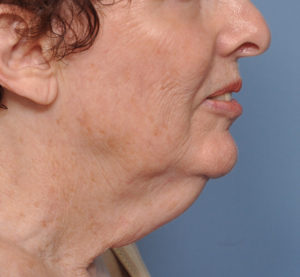
Three specific anatomic factors contribute to a change in one’s neck profile or angle, skin, fat, and muscle. The skin of our face and neck is held up into place through ligaments that run from the underside of the skin down to the bone. (osteocutaneous ligaments) With aging and gravity, these ligaments loosen and the skin and fat from the side of the face and neck begins to fall. This process is accentuated by a loss of elasticity of the skin due to chronic moisture loss and UV irradiation. Together, loose skin develops in the neck and one begins to see the appearance of jowling.
The muscle component of the problem comes from the midline separation of the platysmal muscle. Running from the collarbones up to the lower edge of the jaw, this large sheet of fairly superficial neck muscle keeps fat and other structures tucked up underneath or close to the jaw. As one ages, this thin muscle separates in the midline from the chin down past the adam’s apple in an inverted V fashion. As the muscle splits, the fat in the center of the neck falls furthering contributing to a lowering of the neck angle. In thick-skinned neck with more fat, the neck angle simply becomes more obtuse. In thin-skinned necks, the edges of the muscle can be seen as commonly observed neck bands.
Understanding how the neck ages helps one understand what to do about it. The most successful neck treatment strategies (e.g., facelift) deal with all three anatomic problems, removing fat, tightening skin, and putting the muscle back together. This is why more simple, less invasive procedures such as liposuction alone, skin tightening devices, or small tuck-up operations are not very successful at major neck aging issues. Although they can be useful if they are done when the signs of neck aging are just beginning.
Dr. Barry Eppley
Indianapolis, Indiana


